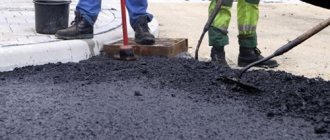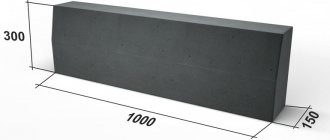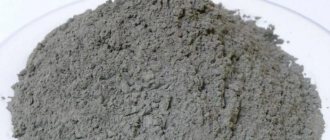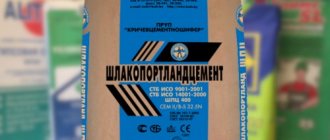The construction of roads in populated areas can be considered complete if a distinction is established between the sidewalk and the roadway, which is made using a road curb. Also, the complex of construction measures to create transport infrastructure includes the creation of landscape design, which includes landscaping of roadside areas.
Functions
A road curb should be understood as a product that separates the sidewalk and the roadway, which allows you to ensure:
- pedestrian safety;
- formation of road boundaries;
- the possibility of tiling sidewalks or asphalting them;
- decorative design of paths in park areas of the city and in local areas of private landholdings.
To manufacture the product in question, durable materials are used, for example, a concrete mixture is used, and the final product is given standardized sizes and shapes.
Main selection criteria
In order to understand how to choose a border, you must first decide for what purpose the border will be used. If it will enclose the sidewalk, then you can purchase a curb that is thinner and smaller in size. This is a reliable and durable building material with increased frost resistance, which is used to delimit pedestrian, bicycle and garden paths.
If it is necessary to separate the sidewalk from the roadway, it is recommended to use a road curb or curb stone. This building material differs from the curb in its large dimensions. The span weight of a sidewalk curb is 33 kg, and that of a road curb is 100 kg. In any case, you need to choose a curb that matches your main sidewalk or road surface.
Important information! A curb with a rounded top prevents unsightly chipping and increases the service life of the tile or paving.
The cost of a sidewalk curb is about $2 per 1 m of building material, and the price of a road curb is $5 per 1 linear meter. Before purchasing any type of border, it is recommended to ask the seller to present a quality document. It should contain the following information: type of production, dimensions of the product and compliance with accepted GOSTs.
The material must have a Russian certificate of conformity issued by the Federal Agency for Metrology and Technical Regulation. You should check whether the document has expired. The certificate confirms that a laboratory accredited by this agency tested the curb, as a result of which experts determined that the characteristics of the building material comply with Russian standards.
Important information! The lack of a Russian registration certificate from the seller is a serious violation. In this case, the characteristics of the material are unknown - wear resistance, absence of radiation, frost resistance, fracture strength.
Helpful advice! When purchasing a border in any volume, you must add an error of 5-10% in case of damage to the building material during installation.
Application of border
- Road, characterized as precast concrete, is a gray product with a rough surface. The front side of this curb is distinguished by the fact that it has a kind of waterline on it, which serves as a limiting line for the rise of wastewater. In accordance with GOST 6665-91, the road curb must have a length of 1,000 mm, a height of 300 mm and a width of 150 mm.
- Magistralny is a side stone with an inclined profile, which allows utilities to clean the roadway more comfortably. Typically, such a curb is laid in populated areas, but cases of its use in the construction of highways outside the city are not uncommon. The length of the main curb is 1,000 mm, width – 180 mm, width – 300 mm.
- Radius - finds its application on those sections of the road where the roadway is rounded without exceeding a radius of 10 m. The length of the product can reach up to 1,000 mm, provided that it is not less than 780 mm, width - 300 mm, height - from 300 to 320 mm.
- Having a beveled profile - a curb installed in places where vehicles enter sidewalks, as well as where there are parking lots.
Regulatory regulation according to GOST
The production characteristics of concrete and reinforced concrete curbs must comply with GOST No. 6665 of 1991, granite - GOST No. 32018 of 2022, and in terms of road safety GOST No. 52289 of 2004.
These regulatory documents define the conditions for the production, transportation, storage and installation of road stones, as well as their marking.
The marking must be applied to the packaging or directly on the surface of the curb stone, and also indicated in product certificates. Marking type: alphanumeric. For example, BR 300-45-18 means a straight ordinary stone with a length of -3 m, a height of 0.45 m and a width of 0.18 m.
Decoding the curb brand according to GOST:
- B - straight;
- R - privates;
- U – with broadening;
- UP - with intermittent broadening;
- L - with tray;
- B - entry type;
- K - curvilinear shape.
What is a road curb made of?
- Reinforced concrete - steel reinforcement and fine-grained concrete are used as the basis, the benefits of which lie in a number of advantages: durability, resistance to mechanical influences, as well as low susceptibility to excess moisture and temperature changes.
- Vibro-compressed concrete mixture - vibroforms are used in production, which guarantees a durable product that is used in cities, since such a curb is durable and is able to react minimally to changes in temperature and humidity.
- Granite is a material with a dense structure that ensures the production of a heavy-duty border that practically does not absorb moisture, is extremely resistant to abrasion, and can withstand any temperature fluctuations, but has a high price.
Technical characteristics of stones
In addition to the requirements, the edge stone must have technical characteristics: it is recommended to consider them in more detail.
Environmental friendliness
Side stones for roads or gardens are considered environmentally friendly, as they are made from clean materials. When using the product, it does not emit harmful substances into the atmosphere and is therefore considered absolutely safe for humans.
If the technology is strictly followed, concrete is an environmentally friendly material and does not pose any danger to human health. When mixing it, only water, sand, crushed stone or crushed stone, and cement are used. None of these materials are harmful to humans.
Frost resistance
Depending on the type of side stone, its frost resistance will differ. For example, a main curb can withstand 300 defrosting and freezing cycles, since its frost resistance is F300 :
The road curb, which is installed on: city roads, courtyard driveways and parking areas, has frost resistance F200.- The garden border, which is suitable for private landscaping of yards and separates garden paths from plots of land, also has a frost resistance of F200.
The specified characteristics will be met if the temperature operating conditions of the curb are met.
Strength grade
The strength grade of the side stone corresponds to the strength grade of the concrete from which it is made. Road and highway side stones have a strength of M400. This means that they are made of M400 concrete.
This material has frost resistance F200-300, high water resistance, and a specific density of more than 2400 kg per cubic centimeter. This brand has P4 mobility, which means excellent workability, which allows the use of such concrete for pouring products with dense reinforcement.
Garden stones have a strength grade of M300 . This indicator indicates that the concrete is lighter in composition, but is close in strength to heavy concrete. It also has high resistance to moisture, good ductility and frost resistance.
Moisture resistance
To make the side stone resistant to moisture, various impurities are added to its composition. But even with the presence of additives, it is able to absorb up to 4% moisture. In the labeling, this indicator is denoted by the letter W :
- For strength grade M300 this will be W5–W6. This means that the stone will not allow water to pass through at a pressure of 0.5-0.6 MPa or at 5-6 atmospheres of pressure.
- The M400 stone strength grade has a moisture permeability class of W6-W12. This indicator is more serious, since the heavy type of concrete is already used for production.
The moisture resistance indicator is influenced by the age of the concrete from which the curb was made, operating conditions in the environment, as well as the additives used in the manufacture of the stone.
Concrete class
If the strength grade of the curbs is M400, then its class will be B30 .
This suggests that heavy concrete is used in production, which is suitable for monolithic structures used under temperature changes and high loads. This class of concrete is also used for pouring reinforced concrete curbs. The material has increased density parameters - 2310 kg/m3.
With a strength grade of M300, the concrete class of the side stone will be B22.5. This is heavy and lightweight concrete, often called universal. Can also be used for reinforced concrete products, reinforced side stones. The density of such a product will be 1600-1900 kg/m3.
Weight
The weight of a curb stone often depends on its size and type. If the product was made from heavy concrete, then its mass will be higher.
For example, a product with dimensions of 500x200x80 mm will weigh 20 kg, while a stone with dimensions of 800x300x150 mm already weighs 85 kg. The heaviest product will be with dimensions of 3000x600x200 mm. Its weight will be 880 kg.
A certain type of stone has a certain weight:
- main line – 120-190 kg;
- road – about 90 kg;
- garden - 18-36 kg.
These indicators should be taken into account when selecting equipment and technology for installing products.
Dimensions
The dimensions of the side stone also depend on its type. For example, there are three types of products :
- Mainline. Its dimensions are 1000x300x180 mm, 1000x450x150 mm or 1000x450x180 mm.
- Road. Its parameters are 1000x300x150 mm.
- Garden. Its dimensions are 1000x200x80 mm or 500x200x80 mm.
also worth highlighting other dimensions (value in millimeters):
- 500x200x80;
- 800x200x80;
- 800x300x150;
- 1000x600x180;
- 1500x300x150;
- 3000x300x150.
The latter options are often used during large-scale construction.
Life time
The average lifespan of curbs ranges from 3 to 20 years. Garden owners often ask themselves the question: how often should edging stones be replaced? The answer is simple - it all depends on the operating conditions.
The durability of the product is affected:
- temperature conditions and changes;
- bad weather;
- the presence of mechanical impact, as well as exposure to moisture.
Another factor is correct installation . If the product was installed incorrectly, then over time this will lead to unsuitability: the stone will become loose in the concrete, there will be a skew and it will simply fall out of the “concrete castle”.
Strength
The strength indicator is also influenced by a lot of factors :
- concrete class;
- strength grade;
- density.
For example , M300 concrete, which is used to make garden stones for edging, has a strength of 295 kgf/cm2 or 28.9 MPa. At the same time, for concrete class B30 this figure will be equal to 393 kg/cm2 or 38.35 MPa.
Laying
During road construction, road curbs are laid using special equipment. As for private land ownership in the form of garden plots, the installation of the border is often done by the owners themselves. To understand this process, let's break it down into several main stages:
- mark the territory using pegs and a rope stretched along the line of the future installation of the curb;
- dig a trench, the depth of which should not be much greater than the height of the curb, maintaining a width of 300 to 400 mm;
- compact the bottom of the trench, lay the sand in one layer and repeat the compaction again;
- prepare a mixture of cement, sand, small crushed stone and water in a ratio of 1: 2.5: 2: 2;
- lay the finished mixture at the bottom of the trench and install a border.
Tiles and mosaics
The blocks can be additionally decorated with mosaics. To do this, they are covered with mortar, shards of tiles or pieces of colored glass are pressed into it and wait for it to harden.
Or you can simply lay out the border for the flower bed with interesting tiles, purchased specifically for this purpose or left over after renovation.
Price
The cost of edge stone with dimensions such as 1000x300x150 depends on its type. At the same time, the average prices for one product in Moscow are as follows:
- side concrete – 215 rubles;
- road – 240 rubles;
- radial - from 255 to 280 rub.
Soda samples of this product can be purchased for 240 rubles. taking into account that they will be slightly smaller: 1000x200x80 - compared to the above example.
We recommend purchasing both the border itself and the curb stone from manufacturers. For example, a curb stone from can be ordered on the page https://plifort.org/bordyur-dorozhnyj/.
How to choose?
According to urban planning legislation, all road surfaces: highway, urban and intra-block and its elements must be installed in accordance with the project, during which the type of curb is selected.
Factors that are taken into account when choosing a curb stone:
climatic characteristics of the development area;- soil characteristics;
- geology;
- standard vehicle load;
- dimensions of the road network;
- curbstone dimensions;
- section profile;
- curb stone material;
- durability for city roads is at least 20 years, for highways - more than 30 years;
- bends of the route.
Production
For the manufacture of road curbs, concrete of the so-called heavy grades is mainly used, which correlates with the use of reinforcement. In the latter case, it is assumed that steel frames will be used, which are created using AIII and AI reinforcement, as well as BpI reinforcing wire. In order to increase the strength of the reinforcement, steel products that have undergone heat treatment can be used.
The actual process of producing road curbs is based on the following types of work:
- prepare a concrete mixture (having a composition depending on the purpose of the side stone), which is then mixed;
- Pigments are added as necessary to give a particular color to the products;
- the mixture is poured into molds of various configurations, for example, a square or a semicircle, which also depends on the purpose of the final product;
- start the molding process using the vibration pressing method;
- after this, the products enter special chambers for drying;
- finished borders are removed from the molds.
A special feature of the side stone is that each copy is supplemented with mounting loops that simplify loading and unloading operations.
Concrete blocks
It is not easy to get a sufficient amount of natural stone; it is much easier to build a border for a flower bed from leftover building materials. It’s a great idea to use concrete blocks; colored and shaped ones look especially good.
But even from ordinary rectangular blocks you can build an original fence, making it multi-tiered, chaotic, or painted in different colors. The main advantage of block borders is the ability to plant plants right inside, which looks very impressive.
Old tires
The use of outdated tires in landscape design is a hackneyed and dubious idea in terms of taste and style, but is still surprisingly popular among summer residents.
Someone cuts the treads off several identical tires and stretches the tape along the border of the flower bed, securing it with wire staples. And someone paints rubber to look like a clay pot and cuts out shaped borders for flower beds from it.
It's easy to build a stand-alone flower garden using a huge tire taken off a truck or a few old car tires stacked in a stack.
Possible errors in operation
There may not be many mistakes when setting curbs . For example, if you do not take into account the proportions of the concrete mixture and measure the components by eye, then the concrete will not be so strong, and under the slightest load it may crumble or crack.
The problem can also occur if the sequence of work is incorrect. Some people first lay the tiles and then install the curb, as a result of which the line along the edge of the blind area may turn out to be crooked and the curb cannot be installed straight (or it can be installed straight, but then there will be a different gap between the covering and the curb).
Conclusion: first the curb is installed, then the covering is laid or poured.
It happens that during the work process there are not enough curbs, although they were ordered based on calculations. It is important to take into account that several curbs may be defective, several elements may fall and break or be damaged due to inexperience. Therefore, materials need to be ordered not just based on the total length of the blind area, but add 10% to this number (for possible errors and damage).
Brick
Now let's turn to the brick. Many owners of self-built private houses still have it in stock, and then it would be an excellent solution to build brick borders for flower beds.
It is not necessary to build a monumental wall; symbolic barriers made of bricks stacked in one line or dug into the ground at an angle also look decent.
Video description
About installing a border in the following video:
Border products are required to be marked, which indicates the dimensions and type of the product, and may also contain additional parameters (for example, the radius of curvature for a curved curb stone). When buying a curb stone, the price of which depends mainly on strength indicators, pay attention to the characteristics declared by the manufacturer. The latter include:
- Dimensions . Garden materials available for sale are 0.5, 1 and 3 meters long. The height is in the range of 20-60 cm, width - 6-15 cm. Curb stones exceeding five meters in length are subject to reinforcement.
- Popular size . The greatest demand is for a standard garden border with dimensions 1000x200x80 (length - height - width in mm). It is easy to install and is ideal for finishing flower beds and the edges of paths.
- Material . According to the production method, vibration-cast and vibration-pressed products are offered.
Border to match the color of the walkway Source besplatka.ua
Slate and corrugated board
Concluding the topic of construction residues, let’s remember roofing materials and metal sheets. If you have tiles or slates lying around, simply dig these fragments into the ground to the desired depth. It is better to additionally strengthen high slate borders for flower beds from the outside.
Unused corrugated sheeting after erecting a fence on the site can be cut into pieces and also dug into the soil along the border of the flower bed. And if you need to make high flower beds, it is better to strengthen the borders, for example, with a wire frame.











